Limping in Children: A Comprehensive Guide
Dr. Sultan Almisfer Pediatric Orthopedic Consultant
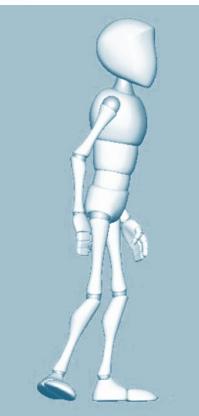
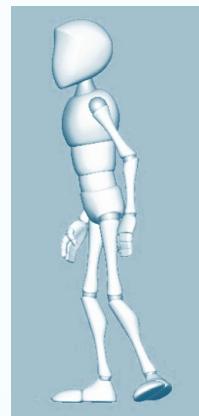
Introduction
- Limping is a common presentation in children and adults
- Can be caused by many diseases
- Need to take a proper:
- History
- Physical examination
- Investigations
- Some diseases related to specific age groups
What is Limping?
- A form of walking that favors the use of one leg over another
- An asymmetric abnormality of the gait
The Normal Gait Cycle
Stance Phase (60%)
- Heel strike
- Foot flat - mid-stance
- Push off
Swing Phase (40%)
- Acceleration
- Mid-swing
- Deceleration
Gait Cycle Summary
Stance Phase - 60% | Swing Phase - 40%

Comprehensive Causes of Limping
Pain-Related Causes
- Trauma
- Bone, ligament, muscle injuries
- Pricks, wounds
- Inflammation
- Degenerative arthritis
- Achilles tendinitis
- Plantar fasciitis
- Inflamed bunion
- Infection
- Joints, bones, toe nails
- Tumors
- Benign osteoid osteoma
- Malignant tumors
- Specific Pediatric Conditions
- Acute slipped capital femoral epiphysis (SCFE)
- Perthe’s disease (Avascular necrosis)
- Sickle cell disease
- Osteochondritis
- Hemophilia
- Leukemia
- Appendicitis / Psoas abscess
Deformity-Related Causes
- Congenital
- DDH (Developmental Dysplasia of the Hip)
- Club foot
- Congenital shortening
- Acquired
- Mal-union
- Developmental issues
- Metabolic conditions
Weakness-Related Causes
- Nerve injuries/diseases
- Muscle weakness
- Secondary to disuse
- Secondary to nerve injury
- Dystrophy
Imbalance-Related Causes
- Inner ear infections
- Cerebellar ataxia
- Neurological conditions
- Stroke, Cerebral palsy
- Parkinson’s Disease
- Multiple sclerosis
- Peripheral nerve disorders
Other Causes
- SCFE (Slipped Capital Femoral Epiphysis)
- Perthe’s disease
- Sickle cell disease
- Osteochondritis
- Hemophilia
- Leukemia
- Appendicitis / Psoas abscess
- Conversion disorders
History Taking
Key Questions
- Onset
- Acute / Gradual
- Duration
- Associated symptoms
- Pain
- Deformity
- Swelling
- Other symptoms
- Fever, night sweating, anorexia, weight loss
Onset Patterns
- Sudden onset
- Trauma
- Gradual onset
- Disease
Pain Assessment in Limping
Painful Limping
- Antalgic gait – short stance phase of gait cycle
Painless Limping
- Normal or prolonged stance phase
Comprehensive Types of Gait Abnormalities
Neurological Gait Patterns
- High steppage
- Foot drop – neurologic disease
- Wide-base
- To gain balance – neurologic disease
- Scissoring
- Tight hip adductors – Cerebral Palsy
- Hemiplegic gait
- Cerebral palsy - neurologic
- Ataxic
- Neurologic disease
- Foot inversion / eversion
- Foot deformity / avoiding pain
Orthopedic Gait Patterns
- Trendelenburg
- DDH, weak hip abductors, could not abduct
- Circumduction
- Stiff hip, neurologic disease
- Tip-toe
- Tight Achilles tendon, CTEV, Cerebral Palsy, habitual, compensating length discrepancy
- Lurching
- Short limb
- Stiff-knee
- Knee disease / arthrogryposis
- Hand-knee
- Weak quadriceps femoris muscle
Walking With Crutches
Contributor: Prof. Mamoun Kremli
Types of Crutches
- Axillary crutches
- Elbow crutches
Indications
- Transfers weight from the legs to the upper body in people who cannot use the legs to support their weight
- Post surgery or casting of the lower limbs
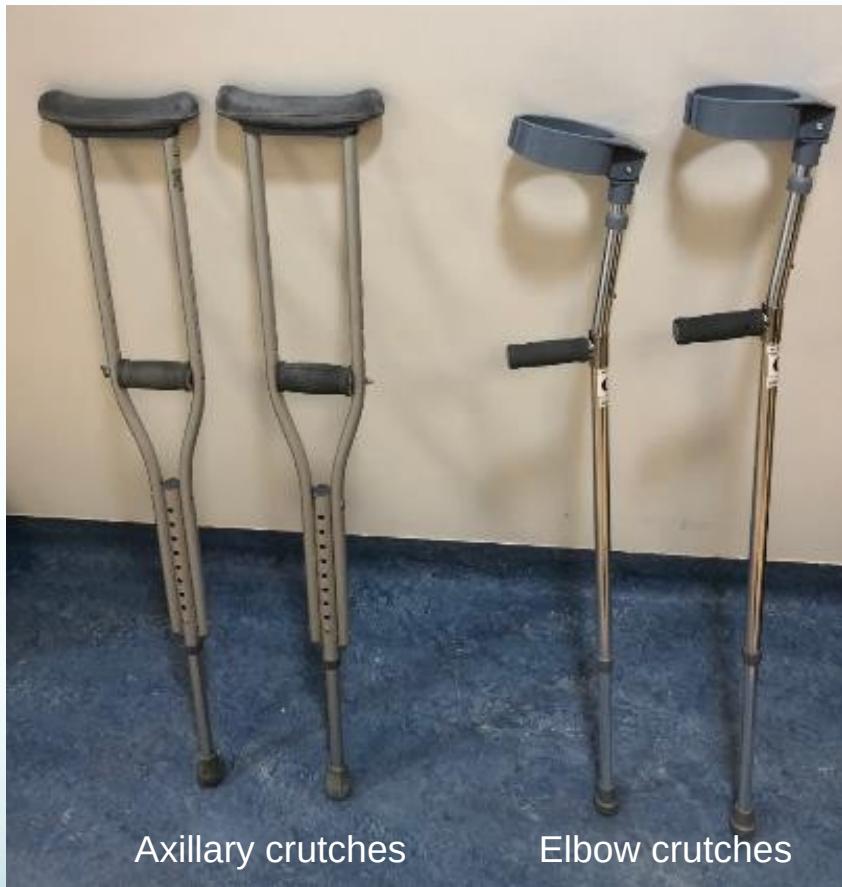
Axillary Crutch Fitting
- Adjust total height
- Axillary part should not press on axilla (5 cm away)
- Adjust hand piece level
- Hand piece at level of wrist
- Elbow slightly flexed during weight transfer
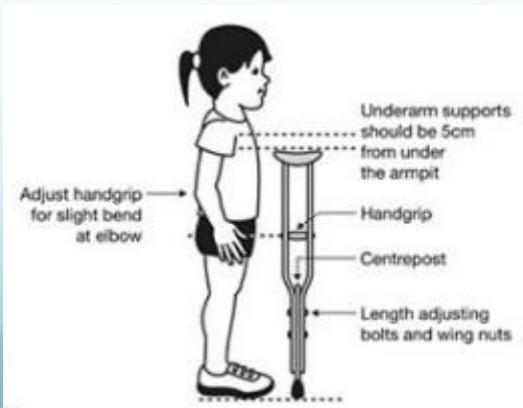
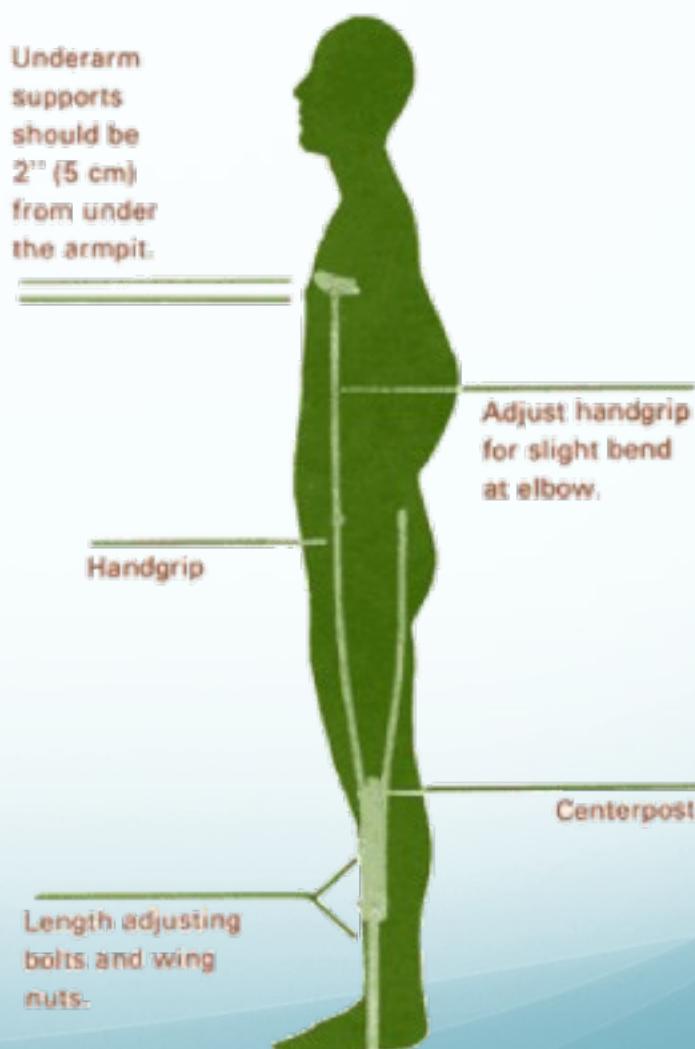
Walking Techniques
Walking With One Crutch

General Directions for Walking with a Crutch:
- Place the crutch under your arm. Squeeze it to the side of your body.
- Move the crutch 6 to 12 inches ahead. It should be slightly away from your body.
- Push down on the hand grip. Step past the crutch.
- Support your weight with your hand and not under your arm.
- Check your balance before you go on.
Step-by-Step Instructions:
- Place the crutch under the arm opposite your weaker leg (see figure above).
- Move the crutch forward and step with your weaker leg at the same time. Keep the crutch close to your body for support and balance (see figure at right).
- Support your weight on both your crutch and your weaker leg. Step past the crutch with your stronger leg (see figure below).
Repeat with the same sequence:
- Step with crutch and weaker leg.
- Step with stronger leg.
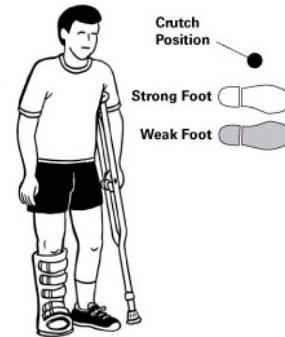
Tips for Walking with a Crutch:
- Carry items in a backpack.
- Do not hang or lean on your crutch. Support all your weight on your hand, not under your arm.
- Maintain good posture when walking.
- Wear shoes that fit well, support your feet, and are comfortable.
- Be careful when walking on uneven or wet surfaces.
- Walk at a safe, comfortable pace.
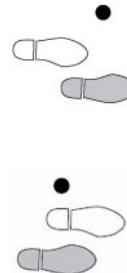
Walking with Two Crutches
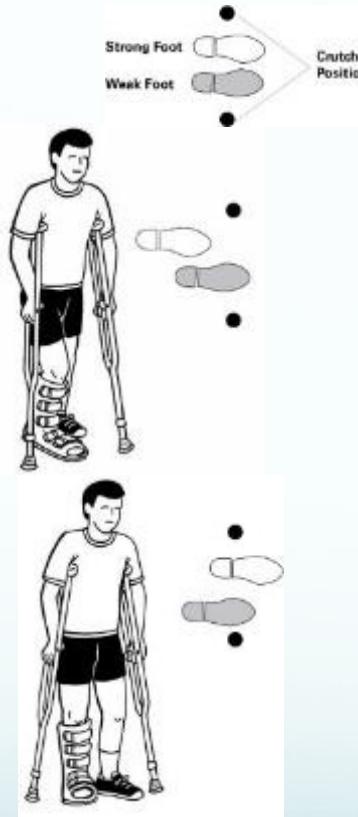
General directions for walking with crutches:
- Place the crutches under your arms. Squeeze them to the sides of your body.
- Move the crutches 6 to 12 inches ahead. They should be slightly away from your body.
- Push down on the hand grips. Step past the crutches.
- Support your weight with your hands and not under your arms.
- Check your balance before you go on.
Step-by-Step Instructions:
- Stand in the middle of your crutches
- Place crutches in front of you and step with your weaker leg at the same time (crutches & weak leg together)
- Push down on the hand grips. With your stronger leg, step up past the crutches with your normal foot
Weight-Bearing Techniques
Non Weight Bearing
- Affected limb off the ground all the time
- Start by standing with all weight on the normal side
- Transfer both crutches forwards
- Small step - not too much forwards
- Put all weight on both crutches through hand pieces
- Transfer normal foot forwards to the line between both crutches
- Do not go beyond the line between both crutches
- Transfer body forwards to level of crutches
Partial Weight Bearing
- Affected leg partially takes weight along with crutches
- Start standing with most weight on normal side, with affected side touching the floor
- Transfer both crutches forwards along with the affected leg
- Small step - not too much forwards
- Put partial weight on crutches through hand pieces and partial weight on affected leg together
- Transfer normal foot forwards to level of crutches
Partial Weight Bearing – More on Affected Leg
- Affected leg takes more weight along with one crutch only
- One crutch held on normal side
- Start standing with most weight on normal side, and affected side touching the floor
- Transfer crutch forwards along with the affected leg together
- Small step - not too much forwards
- Put partial weight on crutch through hand piece and partial weight on affected leg together
- Transfer normal foot forwards to level of crutch
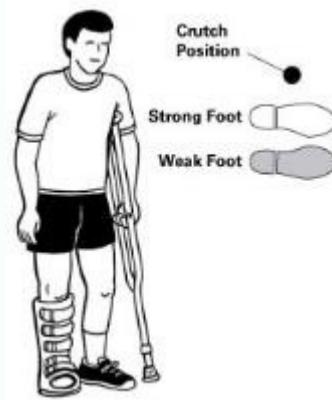

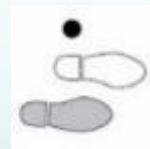
Your therapist may show you different ways to move safely, depending on your situation or environment.
Summary
This comprehensive guide covers the essential aspects of evaluating and managing limping in children, including:
- Definition and assessment of limping
- Normal gait cycle understanding
- Comprehensive causes categorized by pain, deformity, weakness, and imbalance
- History taking and onset patterns
- Gait abnormalities with neurological and orthopedic classifications
- Crutch walking techniques for various weight-bearing scenarios
Remember: Proper evaluation requires a systematic approach combining history, physical examination, and appropriate investigations to identify the underlying cause of limping in children.